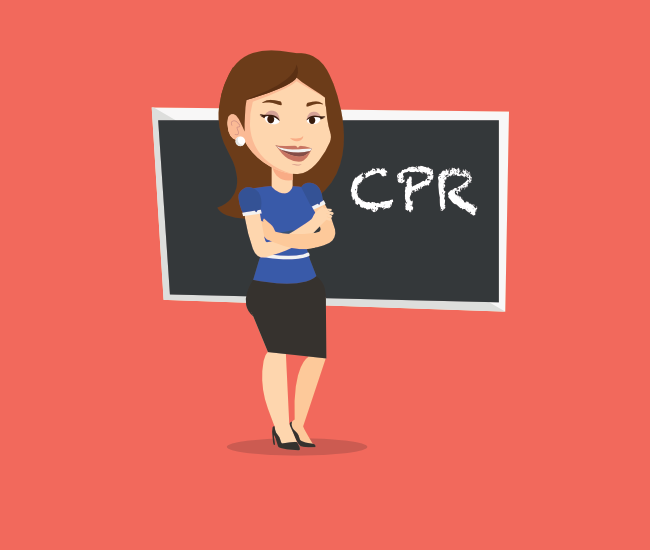If you are a CPR training professional or you hope to be one in the near future, you need to be certified in the material that you hope to teach. Whether you’re up for recertification or are going through it for the first time, there are plenty of courses available where you can learn from other training professionals!
People are counting on you to help them save lives when an emergency situation arises. The only way that you can properly do your job is to keep your knowledge up-to-date. Today, we are going to talk about how you, as a CPR training professional, can get CPR certified or recertified.
How often do CPR training professionals need to get recertified?
This is the first question you should be asking yourself. If you know when you are up for your recertification, you can get the process started before it is too late. CPR training instructors are required to recertify every two years but it is highly recommended that you do so every year. This keeps you up-to-date on all of the latest CPR techniques according to ECC/ILCOR. It also helps keep your knowledge from fading so you stay well qualified to lead a class.
Where can CPR training professionals get CPR certified/recertified?
CPR training professionals can get CPR certified in a number of ways from several organizations or companies. One of the most convenient, affordable, and high-quality places to get your certification is through ProCPR from ProTrainings! Let’s take a look at what ProCPR courses have to offer CPR training professionals.
What types of classes does ProCPR offer?
ProCPR offers several types of classes that CPR training professionals can enroll in. Here’s an in-depth look at the courses offered for certification or recertification.
General CPR (Adults + All Ages)
There are two separate classes for the instruction of general CPR: CPR procedures for adults only and CPR procedures for all ages. This refers not to who can take the class but to who you will be performing CPR on in an emergency. These courses include:
- The five fears of CPR
- How to respond to heart attacks and strokes (medical emergencies)
- Universal precautions to take (hygiene, precautions in the workplace)
- How to respond to cardiac arrest (CPR/AED procedures)
- How to respond when a person is choking
- Bleeding control (stopping the flow of blood in time)
- Special considerations for CPR, AED, and choking
CPR + First Aid (Adults + All Ages)
These CPR classes are also separated into proper procedures on different age groups but they have a few things in common. The CPR + first aid courses from ProCPR include this curriculum:
- The five fears of CPR rescue
- How to respond to heart attacks and strokes (medical emergencies)
- How to respond to cardiac arrest (CPR/AED)
- How to respond when a person is choking (both conscious and unconscious)
- Bleeding control
- Shock control
- Ongoing assessment for injury and illness (i.e. snake bites, diabetes, eye injury, seizures, etc.)
- Heat and cold emergencies (i.e. burns, hypothermia)
- Prevention (i.e. childproofing a house, car backing, poison control, child abuse and neglect)
- Bloodborne pathogens (reducing your risk to exposure)
Healthcare BLS
Healthcare BLS (Basic Life Support) classes combine CPR procedures and other medical training to help healthcare providers gain the knowledge and skills that they need to save lives as part of their job. In this class, healthcare providers learn:
- The five fears of CPR rescue
- How to access EMS with technology
- How to respond to heart attacks and strokes (medical emergencies)
- Universal precautions (hygiene, safety tips)
- Respiratory arrest training (rescue breathing and responding to opioid overdose)
- Cardiac arrest training (CPR/AED)
- How to perform life-saving measures on someone with a spinal injury
- Multiple rescuer skills (two-person CPR/AED, bag valve mask)
- How to respond when a person is choking (both conscious and unconscious)
- Bleeding control (arterial bleeding and shock)
Healthcare BLS + First Aid
Healthcare BLS + first aid classes from ProCPR give you the entire package and help prepare you for every type of medical emergency that you could assist in. It is ideal for CPR training professionals because you get the most comprehensive knowledge. This course includes:
- The five fears of CPR rescue
- How to respond to heart attacks and strokes (medical emergencies)
- Cardiac arrest training (CPR/AED)
- How to respond when a person is choking (both conscious and unconscious)
- Bleeding control (capillary, venous, and arterial bleeding)
- Shock control (shock, fainting)
- Ongoing assessment for injury and illness (i.e. musculoskeletal injury, seizures, amputation, allergies, etc.)
- Heat and cold emergencies (i.e. burns, hypothermia)
- Prevention (i.e. pool safety, child abuse and neglect, car backing, etc.)
- Respiratory arrest training (rescue breathing, valve mask)
- Two rescuer skills training (2-rescuer CPR)
- Bloodborne pathogens (reducing your risk of exposure)
You should be certified in what you plan to teach though you could always go above and beyond to get more comprehensive knowledge and training. In short, CPR training professionals teach you, also a training professional, how to be the best of the best.
You can help others become real-life heroes as long as you keep yourself up-to-date on your own skills and certification. ProCPR training from ProTrainings is meant to help medical professionals and other trainers get certified and stay on top of the newest developments in the world of CPR.
You can take your initial class, pay when you pass, and come back for refresher courses for free at any time!
The cool thing about these classes is that you can learn in a traditional classroom setting, completely online, or do blended classes. Learn at your own pace so you can do your very best and share your knowledge with the public.

